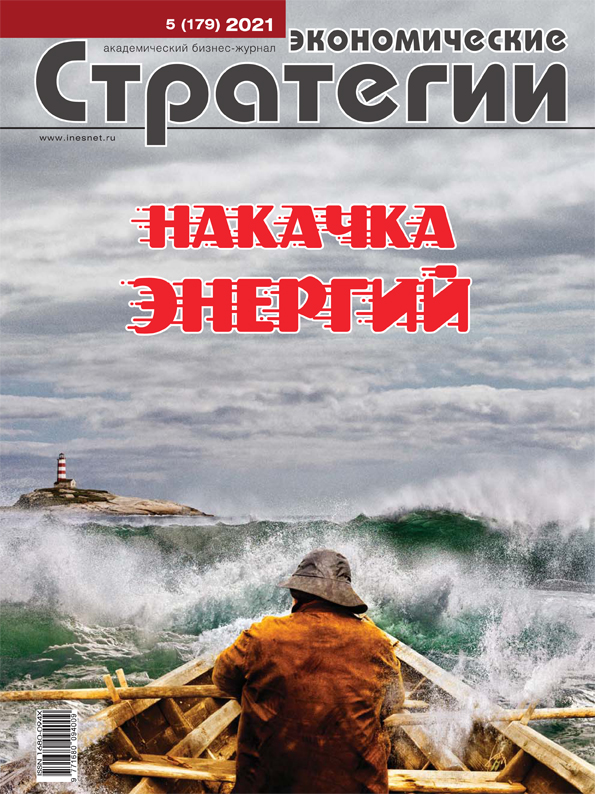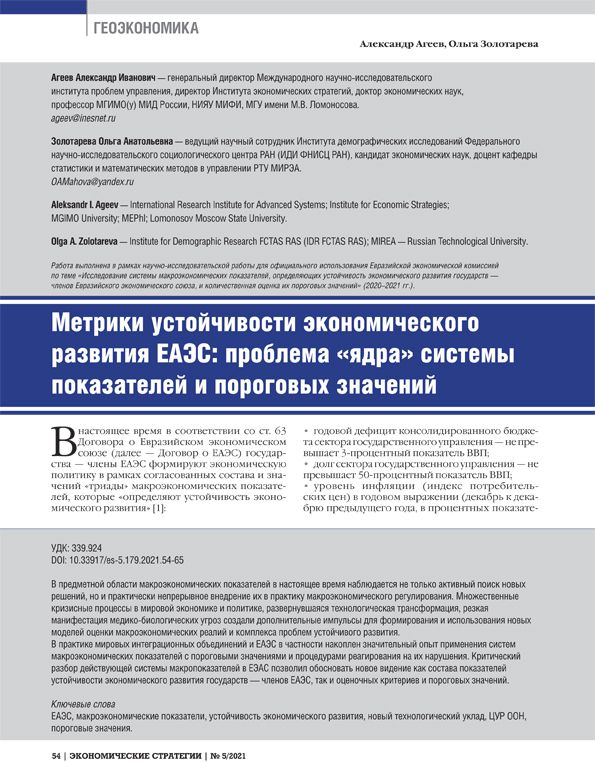Sustainability Metrics of the EAEU Economic Development: Problem of the “Core” of the Indicators and Thresholds System
DOI: https://doi.org/10.33917/es-5.179.2021.54-65
In the subject area of macroeconomic indicators there is currently not only an active search for new solutions, but also their almost continuous implementation in the practice of macroeconomic regulation. Multiple crisis processes in the world economy and politics, unfolding technological transformation, sharp manifestation of medical and biological threats have created additional impulses for forming and applying new models for assessing macroeconomic realities and a set of sustainable development problems. In the practice of world integration associations and the EAEU in particular, considerable experience has been accumulated in applying the systems of macroeconomic indicators with threshold values and procedures for responding to their violations. Critical analysis of the current system of macroeconomic indicators in the EAEU made it possible to substantiate a new vision of both the composition of indicators of sustainable economic development of the EAEU member states and assessment criteria as well as threshold values.
References:
1.Dogovor o Evraziiskom ekonomicheskom soyuze (podpisan v g. Astane 29 maya 2014 g.) (red. ot 15 marta 2018 g.) [Treaty on the Eurasian Economic Union
(Signed in Astana on May 29, 2014) (as Amended on March 15, 2018)]. Konsul’tantPlyus, available at: http://www.consultant.ru/ document/cons_doc_LAW_163855/
2. Perechen’ meropriyatii po realizatsii osnovnykh orientirov gosudarstv — chlenov EAES na 2019–2020 gody [List of Activities to Implement the Main Guidelines
of the EAEU Member States for 2019–2020]. Kodeks, available at: http://docs. cntd.ru/document/560952081.
3. O perechne meropriyatii po realizatsii osnovnykh orientirov gosudarstv — chlenov Evraziiskogo ekonomicheskogo soyuza na 2019–2020 gody [On the List of
Activities to Implement the Main Guidelines of the Eurasian Economic Union Member States for 2019–2020]. Sait Evraziiskoi ekonomicheskoi komissii, available
at: http://www.eurasiancommission.org/ru/act/integr_i_makroec/dep_makroec_pol/moni toring/Documents/Perechen’%202019-2020.pdf.
4. Reshenie Vysshego Evraziiskogo ekonomicheskogo soveta ot 11 dekabrya 2020 g. N 12 “O Strategicheskikh napravleniyakh razvitiya evraziiskoi ekonomicheskoi integratsii do 2025 goda” [Resolution of the Supreme Eurasian Economic Council Dated December 11, 2020 No. 12 “On Strategic Directions for Developing the Eurasian Economic Integration Until 2025”]. Kodeks, available at: https://docs.eaeunion.org/docs/ru-ru/01428320/err_12012021_12.
5. Tseli v oblasti ustoichivogo razvitiya OON [Sustainable Development Goals of the United Nations]. UN.org, available at: https://www.un.org/sustainabledevelopment/ru/sustainable-development-goals/
6. Eko-nomika. Pochemu rossiiskaya ekonomika “pozeleneet” posle koronavirusa [Eco-nomy. Why the Russian Economy will “Turn Green” After the Coronavirus]. RBK. Trendy, available at: https://trends.rbc.ru/trends/green/5ea82ca89a79472db412c14a.
7. Kitai vzyal kurs na “zelenuyu” ekonomiku [China has Set a Course Towards “Green” Economy]. RG.RU, 2021, June, 8, available at: https://rg.ru/2021/06/09/kitaj-planiruet-dostignut-uglerodnoj-nejtralnosti-k-2060-godu.html.
8. Strategiya natsional’noi bezopasnosti Respubliki Armeniya: ustoichivaya Armeniya v menyayushchemsya mire [National Security Strategy of the Republic of Armenia: Sustainable Armenia in a Changing World]. Ofitsial’nyi sait Pravitel’stva Respubliki Armeniya, available at: https://www.gov.am/ru/gov-program/
9. Natsional’naya strategiya ustoichivogo sotsial’no-ekonomicheskogo razvitiya Respubliki Belarus’ na period do 2030 goda [National Strategy for Sustainable Socio-economic Development of the Republic of Belarus for the Period up to 2030]. Ofitsial’nyi sait Ministerstva ekonomiki Respubliki Belarus’, available at: http://www.economy.gov.by/uploads/files/NSUR2030/Natsionalnaja-strategija-ustojchivogo-sotsialno-ekonomicheskogo-razvitija-Respubliki-Belarus-na-perioddo-2030-goda.pdf.
10. Natsional’nyi plan razvitiya Respubliki Kazakhstan do 2025 goda [National Development Plan of the Republic of Kazakhstan Until 2025]. Ofitsial’nyi sait Ministerstva natsional’noi ekonomiki Respubliki Kazakhstan, available at: https://www.gov.kz/memleket/entities/economy/press/news/details/170579?lang=ru; http://adilet.zan.kz/rus/docs/U1800000636
11. Natsional’naya strategiya razvitiya Kyrgyzskoi Respubliki na 2018–2040 gody [National Development Strategy of the Kyrgyz Republic for 2018–2040].
Ofitsial’nyi sait Kabineta ministrov Kyrgyzskoi Respubliki, available at: https://www.gov.kg/ru/programs/8.
12. Ukaz Prezidenta RF ot 21 iyulya 2020 g. N 474 “O natsional’nykh tselyakh razvitiya Rossiiskoi Federatsii na period do 2030 goda” [Decree of the RF President of July 21, 2020 No. 474 “On the National Development Goals of the Russian Federation for the Period up to 2030”]. Ofitsial’nyi sait Prezidenta RF, available at: http://www.kremlin.ru/acts/bank/45726.
13. Ukaz Prezidenta RF ot 2 iyulya 2021 g. N 400 “O Strategii natsional’noi bezopasnosti Rossiiskoi Federatsii” [Decree of the RF President of July 2, 2021 No. 400 “On the National Security Strategy of the Russian Federation”]. Garant, available at: https://www.garant.ru/products/ipo/prime/doc/401325792/
14. Tsentral’nyi bank Respubliki Armeniya. Denezhno-kreditnaya politika [Central Bank of the Republic of Armenia. Monetary Policy]. Tsentral’nyi bank Respubliki Armeniya, available at: https://www.cba.am/ru/SitePages/mpobjective.aspx
15. Natsional’nyi bank Kazakhstana. Denezhno-kreditnaya politika [National Bank of Kazakhstan. Monetary Policy]. Natsional’nyi bank Kazakhstana, available at: https://www.nationalbank.kz/ru/links/dkp.
16. Tsentral’nyi bank Rossiiskoi Federatsii. Osnovnye napravleniya edinoi gosudarstvennoi denezhno-kreditnoi politiki na 2021 god i period 2022 i 2023 godov [Central Bank of the Russian Federation. Main Directions of the General State Monetary Policy for 2021 and the Period of 2022 and 2023]. Tsentral’nyi bank RF, available at: https://cbr.ru/about_br/publ/ondkp/on_2021_2023
17. Natsional’nyi bank Respubliki Belarus’. Osnovnye napravleniya denezhno-kreditnoi politiki Respubliki Belarus’ [National Bank of the Republic of Belarus. Main Directions of the Monetary Policy of the Republic of Belarus]. Natsional’nyi bank Respubliki Belarus’, available at: https://www.nbrb.by/legislation/ondkp.
18. Natsional’nyi bank Kyrgyzskoi Respubliki. Denezhno-kreditnaya politika. Osnovnye napravleniya denezhno-kreditnoi politiki [National Bank of the Kyrgyz Republic. Monetary Policy. Main Directions of the Monetary Policy]. Natsional’nyi bank Kyrgyzskoi Respubliki, available at: https://www.nbkr.kg/index1.jsp?item=1408&lang=RUS.
19. Vsemirnyi bank, available at: https://databank.worldbank.org/source/sustainable-development-goals-(sdgs)#
20. Glaz’ev S.Yu., Lokosov V.V. Otsenka predel’no kriticheskikh znachenii pokazatelei sostoyaniya rossiiskogo obshchestva i ikh ispol’zovanie v upravlenii sotsial’no-ekonomicheskim razvitiem [Assessment of the Extremely Critical Values of Indicators of the State of Russian Society and Their Use in Managing Socio-economic Development]. Vestnik Rossiiskoi akademii nauk, 2012, no 7, pp. 1–28.
21. Sukharev O.S. Struktura ekonomicheskogo rosta stran Evraziiskogo soyuza [Structure of Economic Growth of the Countries of the Eurasian Union]. Ekonomicheskie strategii, 2020, no 2, pp. 112–123, DOI: https://doi.org/10.33917/es-2.168.2020.112-123.



